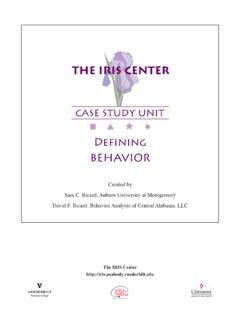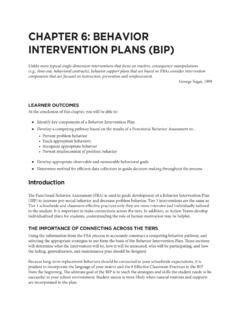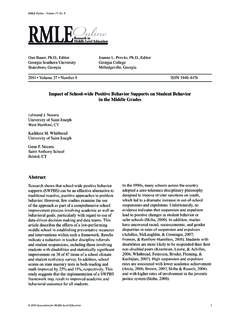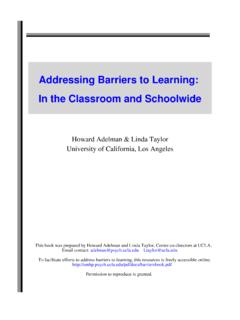Transcription of Strong School–Community Partnerships in Inclusive …
1 9 < strong >schoolstrong > < strong >communitystrong > Journal, 2015, Vol. 25, No. 2 Available at < strong >Strongstrong > < strong >schoolstrong > < strong >communitystrong > < < strong >Strongstrong > >Partnershipsstrong >Strongstrong > > in < < strong >Strongstrong > >Inclusivestrong >Strongstrong > > Schools Are Part of the Fabric of the Count on Them Judith M. S. Gross, Shana J. Haines, Cokethea Hill, Grace L. Francis, Martha Blue-Banning, and Ann P. TurnbullAbstractSchool < strong >communitystrong > < < strong >Strongstrong > >Partnershipsstrong >Strongstrong > > play an essential role in successful schools, often providing supports and resources to meet staff, family, and student needs that go beyond what is typically available through < strong >schoolstrong > . Reciprocally, commu-nity partners benefit from their relationships with schools, including learning about schools < < strong >Strongstrong > >Inclusivestrong >Strongstrong > > culture.
2 To better understand < strong >Strongstrong > < strong >communitystrong > part-nerships and what fosters their development, we conducted focus groups with < strong >communitystrong > partners of five schools. The first main finding presented in this article is that these schools have a variety of partners and < < strong >Strongstrong > >Partnershipsstrong >Strongstrong > > , but all < < strong >Strongstrong > >Partnershipsstrong >Strongstrong > > are reciprocal in that they are mutually beneficial. The second set of findings presented include the < strong >schoolstrong > factors that were facilitators of successful < strong >schoolstrong > < strong >communitystrong > < < strong >Strongstrong > >Partnershipsstrong >Strongstrong > > : < strong >Strongstrong > < strong >schoolstrong > leadership, an invit-ing < strong >schoolstrong > culture, educator commitment to student success, and the ability to collaborate and communicate with < strong >communitystrong > partners.
3 The < strong >communitystrong > partners in many of these schools emphasized how the culture of including all students and providing all students with an excellent education profoundly in-fluenced how they perceived disability and how they used their new knowledge in other settings. Implications for practice and future research are Words: inclusion, < strong >schoolstrong > < strong >communitystrong > < < strong >Strongstrong > >Partnershipsstrong >Strongstrong > > , < < strong >Strongstrong > >Inclusivestrong >Strongstrong > > culture, dis-ability, collaboration, communication, external organizationsSCHOOL < strong >communitystrong > JOURNAL10 IntroductionWillems and Gonzalez-DeHass (2012) described < strong >schoolstrong > < strong >communitystrong > part-nerships as meaningful relationships with < strong >communitystrong > members, organizations, and businesses that are committed to working cooperatively with a shared re-sponsibility to advance the development of students intellectual, social, and emotional well-being.
4 < strong >schoolstrong > < strong >communitystrong > < < strong >Strongstrong > >Partnershipsstrong >Strongstrong > > can impact student success and post- < strong >schoolstrong > outcomes as well as positively influence and benefit the < strong >communitystrong > in return. Auerbach (2010) characterized authentic < < strong >Strongstrong > >Partnershipsstrong >Strongstrong > > as respectful alliances among educators, families, and < strong >communitystrong > groups that value relationship building, dialogue, and power sharing as part of a socially just, democratic < strong >schoolstrong > (p. 729). The development of authentic, trusting rela-tionships is germane to establishing effective < strong >schoolstrong > < strong >communitystrong > involvement in schools is a critical component for student achievement (Anderson, Houser, & Howland, 2010; Bryk, 2010; Coleman, 1988; McAlister, 2013; Sanders, 2006).
5 Research shows schools that develop < strong >Strongstrong > < strong >communitystrong > < < strong >Strongstrong > >Partnershipsstrong >Strongstrong > > have (a) a higher percentage of students per-forming on grade level (Sheldon, 2003), (b) increased parental volunteerism (Anderson et al., 2010), (c) supported < strong >schoolstrong > reform efforts (McAllister, 2013), (d) increased student test scores (Blank, Melaville, & Shah, 2003; Sheldon, 2007), (e) increased student attendance rates (Sheldon, 2003, 2007; Sheldon & Epstein, 2004), and (f ) connections for students to learning opportunities outside of < strong >schoolstrong > (Blank et al.)
6 , 2003). Because of their < strong >Strongstrong > influence on stu-dents, families, and schools, trusting < strong >communitystrong > < < strong >Strongstrong > >Partnershipsstrong >Strongstrong > > are an integral feature of the < strong >schoolwidestrong > Integrated Framework for Transformation (SWIFT). SWIFT is an evidence-based theoretical framework for a fully braided, in-clusive educational delivery system that extends beyond the < strong >schoolstrong > to include families and < strong >communitystrong > , as well as state and district policies and practices (Mc-Cart, Sailor, Bezdek, & Satter, 2014; Sailor & Roger, 2005; Sailor et al., 2006).
7 We define evidence-based as practices drawn from research studies that have been replicated numerous times with defined, measurable outcomes indicating effectiveness. < < strong >Strongstrong > >Inclusivestrong >Strongstrong > > schools educate all students in learning environments that practice equity-based inclusion of all children, where every student is valued as a member of his or her neighborhood < strong >schoolstrong > and is provided the sup-ports needed to achieve social and academic success. The SWIFT framework integrates five evidence-based domains as the foundation of effective < < strong >Strongstrong > >Inclusivestrong >Strongstrong > > < strong >schoolstrong > transformation (see Figure 1): (a) administrative leadership ( , Ainscow & Sandhill, 2010; Burrello, Hoff-man, & Murray, 2005; Marzano, Waters, & McNulty, 2005; Waldron & McLeskey, 2010), < < strong >Strongstrong > >Partnershipsstrong >Strongstrong > > IN < < strong >Strongstrong > >Inclusivestrong >Strongstrong > > SCHOOLS11(b) multi-tiered system of support ( , Bradshaw, Mitchell, & Leaf, 2010; Lane, Oakes, & Menzies, 2010.)
8 Sugai, Simonsen, Bradshaw, Horner, & Lewis, 2014), (c) integrated educational framework ( , Hang & Rabren, 2009; O Day, 2002; Wenger, 2000), (d) family and < strong >communitystrong > engagement ( , Anderson-Butcher et al., 2008; Bryk, 2010; Lawson & Sailor, 2000), and (e) < < strong >Strongstrong > >Inclusivestrong >Strongstrong > > policy structure and practice ( , Burrello, Sailor, & Kleinham-mer-Tramill, 2013; Kozleski & Smith, 2009). While the SWIFT framework is appropriate for any < strong >schoolstrong > (O Rourke, 2014; Ryndak, Jackson, & White, 2013), it is especially beneficial for trans-forming schools that struggle with low achievement, high rates of problem behavior, and segregated delivery of specialized services.
9 As such, the Department of Education, Office of Special Education Programs (OSEP) es-tablished the National Center on < strong >schoolwidestrong > < < strong >Strongstrong > >Inclusivestrong >Strongstrong > > Reform, referred to as SWIFT Center, to provide intensive technical assistance to K 8 urban, rural, and high need schools, along with their districts and state education agencies, to improve outcomes for students with disabilities while transforming schools to positively impact all students ( Department of Education, 2012).SWIFT Center defines the domain of family and < strong >communitystrong > engagement as < strong >Strongstrong > , ongoing, collaborative working are developed with consideration of the unique culture of the < strong >communitystrong > [and] allow for stakeholder input in the design, implementation, evaluation, and continuous improvement of the system (SWIFT Center, 2013, p.)
10 3). We define the fea-ture of trusting < strong >communitystrong > < strong >schoolstrong > < < strong >Strongstrong > >Partnershipsstrong >Strongstrong > > as < < strong >Strongstrong > >Partnershipsstrong >Strongstrong > > contributing to < strong >positivestrong > student outcomes and occurring when schools work collaboratively with < strong >communitystrong > members, agencies, organizations, businesses, and industry around common goals, resulting in (a) direct participation by < strong >communitystrong > rep-resentatives in < strong >schoolstrong > leadership, and (b) enhanced < strong >communitystrong > resources. In other words, < < strong >Strongstrong > >Partnershipsstrong >Strongstrong > > between schools and < strong >communitystrong > members benefit students, families, schools, communities, or any combination of these parties (Sanders, 2006).


















